
Following its six 2010 Tony wins (including Best Play), John Logan’s Red now gets its very first from-the-ground-up Los Angeles-area staging at Long Beach’s International City Theatre, and what a splendid production ICT has mounted under the astute, nuanced direction of its Artistic Director caryn desai.
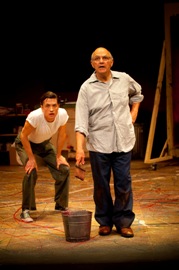 Tony Abatemarco is world-famous painter Mark Rothko (circa 1958) and Patrick Stafford his fictional young assistant Ken, hired around the time that Rothko had been commissioned to create a series of mural-sized paintings for the soon-to-be-opened Four Seasons Restaurant in Seagram & Sons’ fancy new Park Avenue digs, the 38-story Seagram Building.
Tony Abatemarco is world-famous painter Mark Rothko (circa 1958) and Patrick Stafford his fictional young assistant Ken, hired around the time that Rothko had been commissioned to create a series of mural-sized paintings for the soon-to-be-opened Four Seasons Restaurant in Seagram & Sons’ fancy new Park Avenue digs, the 38-story Seagram Building.
Rothko makes it clear from Day One that he will be neither rabbi nor father nor shrink nor friend to Ken, and that whatever tasks he assigns his assistant will be of the most menial variety. “You’ll help me stretch the canvases and mix the paints and clean the brushes and build the stretchers and move the paintings and also help apply the ground color—which is not painting, so any lunatic assumptions you make in that direction you need to banish immediately.”
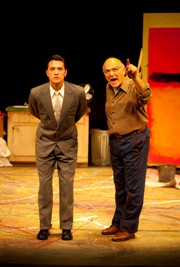 Though Rothko does ask Ken’s opinion of his latest canvas at their first meeting, what the young man thinks about Rothko’s art, or art of any kind for that matter, is of no interest whatsoever to the painter. Indeed at one point, Rothko (an egomaniacal bully if ever there was one) goes so far as to rail, “By what right do you speak? Who the fuck are you? What have you done?” (These are rhetorical questions, since Rothko seems to have no curiosity whatsoever about Ken’s life or work outside his studio.)
Though Rothko does ask Ken’s opinion of his latest canvas at their first meeting, what the young man thinks about Rothko’s art, or art of any kind for that matter, is of no interest whatsoever to the painter. Indeed at one point, Rothko (an egomaniacal bully if ever there was one) goes so far as to rail, “By what right do you speak? Who the fuck are you? What have you done?” (These are rhetorical questions, since Rothko seems to have no curiosity whatsoever about Ken’s life or work outside his studio.)
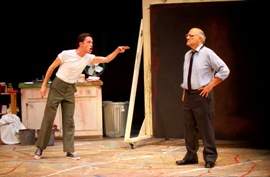 Still, mouse our young Ken may well have been upon being hired by Rothko The Great And Terrible, Red really takes flight when the assistant begins to acquire his own voice, calling into question Rothko’s integrity as an artist in pocketing a cool $35,000 (about $275,000 in today’s currency) to provide artwork for what was to be, after all, nothing more than an upscale eatery.
Still, mouse our young Ken may well have been upon being hired by Rothko The Great And Terrible, Red really takes flight when the assistant begins to acquire his own voice, calling into question Rothko’s integrity as an artist in pocketing a cool $35,000 (about $275,000 in today’s currency) to provide artwork for what was to be, after all, nothing more than an upscale eatery.
And though Rothko may take great pleasure in pooh-poohing predecessors like Picasso, contemporaries like Pollock, and young whippersnappers like Warhol, Ken eventually finds himself taking equal pleasure in putting Rothko in his place, which as far as the young man is concerned, seems increasingly to be situated in past tense.
Not surprisingly, Red can get talky (as when Rothko gets to comparing Apollo and Dionysius), but intelligent talk it is, much of it about Art with a capital A. Rothko can be philosophical, as when he explains to Ken, “Most of painting is thinking. Ten percent is putting paint on canvas. The rest is waiting.” He can be arrogant, as when he declares about those who loathe him and his work, “They do not have the heart, nor the patience, nor the capacity, to think, to understand, because they are not human beings.” And he can be poetic, as when he confesses that selling one of his paintings is like “sending a blind child into a room full of razor blades.”
Still what makes Red sizzle, and particularly with a pair of actors as gifted as Abatemarco and Stafford, is a relationship between the two men that ends up far more like the one Rothko initially rejects (rabbi-pupil, father-son, shrink-patient, friend-friend) than he ever could have foreseen, or would likely have admitted to.
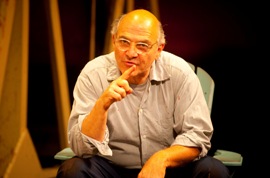 In what is surely a career high for the accomplished character actor, Abatemarco is a veritable force of nature as force-of-nature Rothko, whether railing against a pop culture that “likes” everything from television to soda pop to shampoo to Cracker Jack, or imparting pearls of wisdom (“To be civilized is to know your where you belong in the continuum of your art and your world.”), or cracking the occasional joke about, say, Caravaggio, who (in the Gospel According To Rothko) supposedly prayed, “‘God, help me, unworthy sinner that I am. Tell me, O Lord on High, what the fuck do I do now?”
In what is surely a career high for the accomplished character actor, Abatemarco is a veritable force of nature as force-of-nature Rothko, whether railing against a pop culture that “likes” everything from television to soda pop to shampoo to Cracker Jack, or imparting pearls of wisdom (“To be civilized is to know your where you belong in the continuum of your art and your world.”), or cracking the occasional joke about, say, Caravaggio, who (in the Gospel According To Rothko) supposedly prayed, “‘God, help me, unworthy sinner that I am. Tell me, O Lord on High, what the fuck do I do now?”
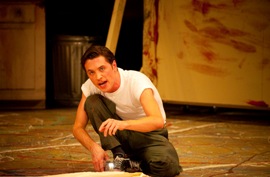 Giving as good as he gets is the extraordinary Stafford, whose 2009 performance as Alan Strang in Equus not only introduced Los Angeles to the gifted young Boston Conservatory grad, it won him the first of two Best Lead Actor Scenies and set him on a career path that has included increasingly frequent TV guest star roles, and now Red. Much of Stafford’s work in Red consists of active listening (a challenge that he meets with flying colors), making it all the more powerful and moving when Ken begins to do more than respond in short sentences, most notably in a devastating recollection of his parents’ murder, and later—when at long last Rothko’s mouse gains a lion’s voice—in putting his master in his place.
Giving as good as he gets is the extraordinary Stafford, whose 2009 performance as Alan Strang in Equus not only introduced Los Angeles to the gifted young Boston Conservatory grad, it won him the first of two Best Lead Actor Scenies and set him on a career path that has included increasingly frequent TV guest star roles, and now Red. Much of Stafford’s work in Red consists of active listening (a challenge that he meets with flying colors), making it all the more powerful and moving when Ken begins to do more than respond in short sentences, most notably in a devastating recollection of his parents’ murder, and later—when at long last Rothko’s mouse gains a lion’s voice—in putting his master in his place.
Like a pair of finely tuned instruments, Abatemarco and Stafford’s synergistic work together includes some clever word play (a sequence in which the duo parry metaphors about the color red is one of the play’s most exhilarating) and one particularly remarkable scene of physical collaboration that you’ll be recalling for months to come.
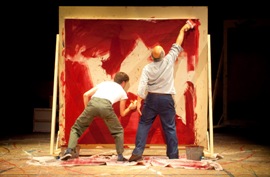 Red is as gorgeously designed a production as I’ve seen at ICT, beginning with JR Bruce’s minutely detailed artist’s studio set, impeccably dressed by resident property designers Patty, Gordon, and Christopher Briles and lit to exquisite perfection by Donna Ruzika. (Note how daylight appears to be shining through the grimy windows hanging down from the rafters.) Resident sound designer Dave Mickey backs the action with carefully selected pieces of classical music. Resident costume designer Kim DeShazo has created outfits for Rothko and Ken that match both character and era. Anthony Gagliardi is resident hair and wig designer.
Red is as gorgeously designed a production as I’ve seen at ICT, beginning with JR Bruce’s minutely detailed artist’s studio set, impeccably dressed by resident property designers Patty, Gordon, and Christopher Briles and lit to exquisite perfection by Donna Ruzika. (Note how daylight appears to be shining through the grimy windows hanging down from the rafters.) Resident sound designer Dave Mickey backs the action with carefully selected pieces of classical music. Resident costume designer Kim DeShazo has created outfits for Rothko and Ken that match both character and era. Anthony Gagliardi is resident hair and wig designer.
Henry Fernandez is production stage manager and Sierra Baggins is assistant stage manager. Michael Donovan, CSA is resident casting director and Richie Ferris is casting assistant.
In a season that has already included memorable stagings of Around The World In 80 Days, Master Class, and Dead Man’s Cell Phone, this very first made-for-L.A. production of John Logan’s Red once again places International City Theatre in the top tier of Los Angeles-area regional theaters. It is a production you will not want to miss.
International City Theatre, Long Beach Performing Arts Center, 300 E. Ocean Blvd., Long Beach.
www.InternationalCityTheatre.org
–Steven Stanley
August 24, 2013
Photos: Suzanne Mapes
Tags: International City Theatre, John Logan, Los Angeles Theater Review, Mark Rothko


 Since 2007, Steven Stanley's StageSceneLA.com has spotlighted the best in Southern California theater via reviews, interviews, and its annual StageSceneLA Scenies.
Since 2007, Steven Stanley's StageSceneLA.com has spotlighted the best in Southern California theater via reviews, interviews, and its annual StageSceneLA Scenies.







 COPYRIGHT 2025 STEVEN STANLEY :: DESIGN BY
COPYRIGHT 2025 STEVEN STANLEY :: DESIGN BY